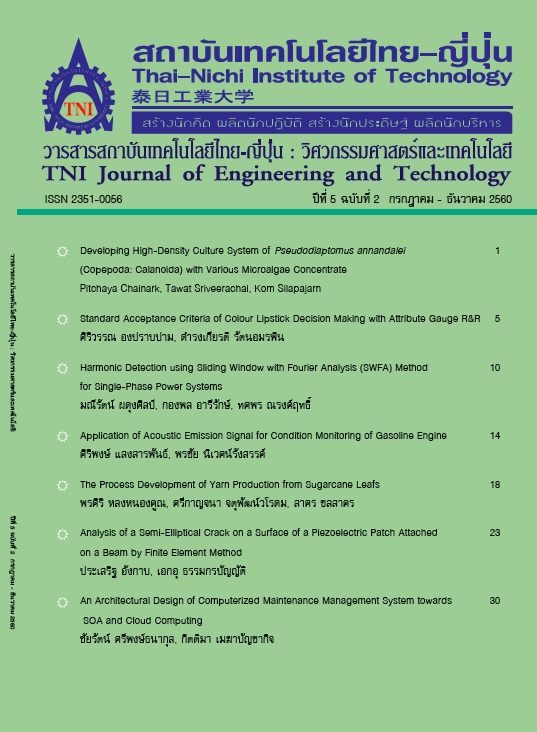Analysis of a Semi-Elliptical Crack on a Surface of a Piezoelectric Patch Attached on a Beam by Finite Element Method
Main Article Content
Abstract
This research intends to investigate the effects of some parameters to the stress intensity factor of a semi-elliptical surface crack under the open mode condition. The model has been simplified from cracking failures which occurred at piezoelectric patches embedded on an actuator arm in hard disk drive. Thus a cantilever beam with a piezoelectric patch subject to bending moment at its free end is chosen. Stress intensity factors at crack fronts are then calculated by a commercial finite element software, ANSYS. From the numerical results, crack size ratio and crack position have significant effects to the stress intensity factor. When the crack size ratio is increased (the crack depth is increased until equal to the half crack length) the maximum KI will also be increased. For crack position, more closer to the edge of a piezoelectric patch the KI will be higher. In the other hand, the piezoelectric patch position is not affect to KI.
Article Details
Article Accepting Policy
The editorial board of Thai-Nichi Institute of Technology is pleased to receive articles from lecturers and experts in the fields of engineering and technology written in Thai or English. The academic work submitted for publication must not be published in any other publication before and must not be under consideration of other journal submissions. Therefore, those interested in participating in the dissemination of work and knowledge can submit their article to the editorial board for further submission to the screening committee to consider publishing in the journal. The articles that can be published include solely research articles. Interested persons can prepare their articles by reviewing recommendations for article authors.
Copyright infringement is solely the responsibility of the author(s) of the article. Articles that have been published must be screened and reviewed for quality from qualified experts approved by the editorial board.
The text that appears within each article published in this research journal is a personal opinion of each author, nothing related to Thai-Nichi Institute of Technology, and other faculty members in the institution in any way. Responsibilities and accuracy for the content of each article are owned by each author. If there is any mistake, each author will be responsible for his/her own article(s).
The editorial board reserves the right not to bring any content, views or comments of articles in the Journal of Thai-Nichi Institute of Technology to publish before receiving permission from the authorized author(s) in writing. The published work is the copyright of the Journal of Thai-Nichi Institute of Technology.
References
จิรพงศ์ กสิวิทย์อำนวย, กลศาสตร์การแตกหัก. กรุงเทพฯ: คณะวิศวกรรมศาสตร์ จุฬาลงกรณ์มหาวิทยาลัย, 2553.
Dowling, N.E., Mechanical behavior of materials Engineering methods for deformation, fracture, and fatigue ,2Edition, Prentice-Hall: New Jersey, 1999.
C. D. Wilson, “Fracture problems with ANSYS: A (Very) Brief Introduction,” [Online]. Available: https://www.cae.tntech.edu/~chriswilson/FEA/ANSYS/ANSYS_Lab_Notes.pdf. [Accessed: September 11, 2014].
J. C. Newman, Jr., “Fracture analysis of surface- and through-cracked sheets and plates,” Engineering Fracture Mechanics, vol. 5, no. 3, pp. 667-689, September 1973.
F. W. Smith and D. R. Sorensen, “The semi-elliptical surface crack–A solution by the alternating method,” International Journal of Fracture, vol. 12, no. 1, pp. 47-57, February 1976.
R. C. Shah and A. S. Kobayashi, “Stress intensity factor for an elliptical crack under arbitrary normal loading,” Engineering Fracture Mechanics, vol. 3, no. 1, pp. 71-96, July 1971.
I. S. Raju and J. C. Newman, Jr., “Improved stress-intensity factors for semi-elliptical surface cracks in finite-thickness plates,” NASA Technical Memorandum, NASA TM X – 72825, June 1977.
I. S. Raju and J. C. Newman, Jr., "Stress-intensity factors for a wide range of semi-elliptical surface cracks in finite-thickness plates," Engineering Fracture Mechanics, vol. 11, no. 4, pp. 817-829, 1979
J. C. Newman, Jr. and I. S. Raju, “An empirical stress-intensity factor equation for the surface crack,” Engineering Fracture Mechanics, vol. 15, no. 1–2, pp. 185-192, 1981.
T. Nishioka and S. N. Atluri, “Analytical solution for embedded elliptical cracks, and finite element alternating method for elliptical surface cracks, subjected to arbitrary loadings,” Engineering Fracture Mechanics, vol. 17, no. 3, pp. 247-268, 1983.
X. K. Zhu et al., “Three-dimensional stress and displacement fields near an elliptical crack front,” International Journal of Fracture, vol. 109, no. 4, pp. 383-401, June 2001.
S. Ploypech et al., “Crack initiation and propagation of galvanized coatings hot-dipped at 450C under bending loads,” Surface & Coatings Technology, vol. 206, no. 18, pp. 3758-3763, May 2012.
X. N. Li et al., "Thickness-dependent fracture characteristics of ceramic coatings bonded on the alloy substrates," Surface & Coatings Technology, vol. 258, pp. 1,039 – 1,047, November 2014.


